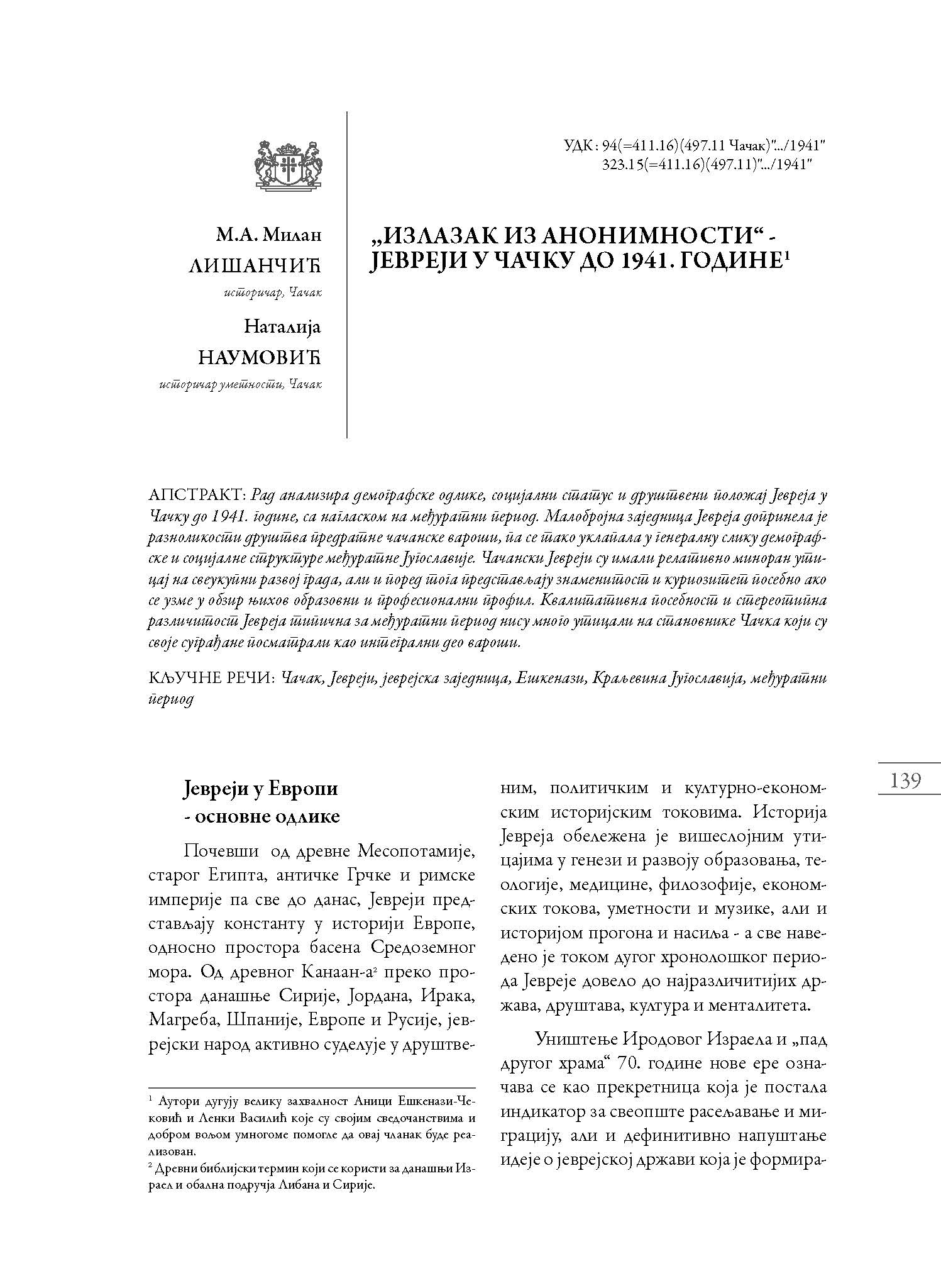Приказ основних података о документу
"Izlazak iz anonimnosti" - Jevreji u Čačku do 1941. godine
"Coming out from anonimity" - Јews in Cacak up to 1941
| dc.creator | Lišančić, Milan | |
| dc.creator | Naumović, Natalija | |
| dc.date.accessioned | 2023-10-09T15:56:20Z | |
| dc.date.available | 2023-10-09T15:56:20Z | |
| dc.date.issued | 2014 | |
| dc.identifier.issn | 0350-7262 | |
| dc.identifier.uri | https://www.jevrejskadigitalnabiblioteka.rs/handle/123456789/2544 | |
| dc.description.abstract | Rad analizira demografske odlike, socijalni status i društveni položaj Jevreja u Čačku do 1941. godine, sa naglaskom na međuratni period. Malobrojna zajednica Jevreja doprinela je raznolikosti društva predratne čačanske varoši, pa se tako uklapala u generalnu sliku demografske i socijalne strukture međuratne Jugoslavije. Čačanski Jevreji su imali relativno minoran uticaj na sveukupni razvoj grada, ali i pored toga predstavljaju znamenitost i kuriozitet posebno ako se uzme u obzir njihov obrazovni i profesionalni profil. Kvalitativna posebnost i stereotipna različitost Jevreja tipična za međuratni period nisu mnogo uticali na stanovnike Čačka koji su svoje sugrađane posmatrali kao integralni deo varoši. | sr |
| dc.description.abstract | The paper analyses the social position, as well as social-demographic characteristics of the Čačak Jewish community up to 1941. Although not numerous, Čačak Jews represent historical value, curiosity and their characteristics help in getting a bigger picture of Čačak society in the period between the wars. The number of Jews in the Kingdom of SCS/ Yugoslavia did not exceed 0, 53% out of the total population while in Čačak it was only 0, 24% in 1921 and about 0, 48% in 1941, thus it can be concluded that the Čačak Jewish community, as well as Yugoslav one, belonged to minor one in the whole of Europe. Differently from demographic features which were not on the European average, the social, educational and professional structure of Čačak Jews certainly was. Throughout history, Jews in Čačak mainly presented intellectual elite and upper middle class in generally rural Čačak society in the period between the wars. Profile of Čačak family Ashkenazi is a clear example of this condition but it also reflects a general picture of Jewish communities in Serbia. There was no anti-Semitism in Čačak town apart from ‘modernity’ between the wars which was coming from Russia in the 20s and Hitler Germany in the 30s and which could be found in some newspapers and magazines in Čačak. The status of Jews in the Kingdom was based on laws and special regulations, but the relationship towards Čačak Jews was close to phylo-Semitism contributing in that way to the homogeneity of Čačak society and creating a complete ‘domestic atmosphere’ where Jewish families lived and created freely and undisturbed. | sr |
| dc.description.abstract | Cette étude analyse la position sociale, ainsi que les particularités socio-démographiques de la communauté juive de Cacak jusqu’à l’année 1941. Bien que peu nombreux, les Juifs de Cacak représentent une attraction historique, une curiosité et avec leurs caractéristiques aident à l’obtention d’une image complète de la société de Cacak durant la période d’entre-deux-guerres. Le nombre de Juifs dans la Royaume SHS/ la Yougoslavie ne dépassa pas 0,53% du chiffre total des habitants, tandis que ce rapport à Cacak fut à peine entre 0,24% en 1921 et vers 0,48% en 1941 et, par conséquent, on peut constater que la communauté juive de Cacak, tout comme la communauté yougoslave, appartint à l’une des plus mineures dans l’Europe entière. À la différence des particularités démographiques qui ne furent pas dans la moyenne européenne, la structure sociale, instructive, ainsi que professionnelle des Juifs de Cacak le fut certainement. Durant l’Histoire, les Juifs représentèrent à Cacak l’élite intellectuelle et la classe moyenne supérieure dans la société de Cacak, rurale en général, de la période d’entre-deux-guerres. Le profil de la famille Eshkenazi de Cacak est une représentation précise de cette situation, mais elle reflète principalement aussi l’image générale des communautés juives dans la Serbie toute entière. Il n’y eut pas en fait d’antisémitisme dans la ville de Cacak, à part la „modernité“ d’entre-deuxguerres qui arriva dans les années 20 de Russie et dans les années 30 de l’Allemagne d’Hitler et qui fut suivie dans une certaine mesure par quelques journaux et revues de Cacak. En dehors du fait que le statut des Juifs dans le Royaume fut établi sur des lois et des clauses particulières, la relation envers les Juifs de Cacak avoisina le philosémitisme en contribuant à l’homogénéité de la société de Cacak, mais également en créant une „atmosphère chaleureuse“ absolue dans laquelle les familles juives vécurent et travaillèrent tranquillement. | sr |
| dc.language.iso | sr | sr |
| dc.publisher | Čačak : Narodni muzej | sr |
| dc.rights | openAccess | sr |
| dc.rights.uri | https://creativecommons.org/licenses/by-nc-nd/4.0/ | |
| dc.source | Zbornik radova Narodnog muzeja (Čačak) | sr |
| dc.subject | Jevreji - Čačak | sr |
| dc.subject | jevrejska zajednica - Čačak | sr |
| dc.subject | Jews - Čačak | sr |
| dc.subject | Jewish community - Čačak | sr |
| dc.title | "Izlazak iz anonimnosti" - Jevreji u Čačku do 1941. godine | sr |
| dc.title | "Coming out from anonimity" - Јews in Cacak up to 1941 | sr |
| dc.title | "La sortie de l’anonymat" - les Juifs à Cacak jusqu’à l’année 1941 | sr |
| dc.type | article | sr |
| dc.rights.license | BY-NC-ND | sr |
| dc.identifier.fulltext | http://jevrejskadigitalnabiblioteka.rs/bitstream/id/8122/IzlazakIzAnonimnostiJevrejiUCackuDo1941OCR.pdf | |
| dc.type.version | publishedVersion | sr |
| dc.citation.spage | 139 | |
| dc.citation.epage | 160 | |
| dc.citation.volume | 44 | |
| dc.identifier.cobiss | 219618828 | |
| dc.identifier.rcub | https://hdl.handle.net/21.15107/rcub_jdb_2544 |

